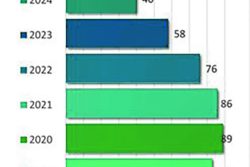If the projections of the joint Economic Commission for Latin America and the Caribbean (ECLAC) and the International Labour Organization (ILO) are anything to go by, the post COVID-19 economy experience of Latin America and the Caribbean is likely to pose some of the sternest challenges and will require “active macro policies …along with sectorial policies that would promote sustainable development with employment” in order to lessen the strain that could attend recovery.
In a joint Report issued earlier this month, the two international agencies assert that post-COVID-19 labour market reactivation in the region is likely to be sluggish and “it will take a lot of time for the world of work’s main indicators to return to the levels seen before the health crisis.” Furthermore, the report says, it will take even more time to be able to meet the targets established in the Sustainable Development goals.
And the two international agencies say in a media release that summarizes the content of the report that the pursuit of reviving the economies of Latin America and the Caribbean must put women, young people and small businesses first.
The Report states that returning to pre-pandemic economic activity levels will take several years and that this is certain to translate into a slow recovery in employment. Assuming that the average growth in regional Gross Domestic Product (GDP) holds steady at 3.0%, overall GDP is unlikely to return to 2019 levels any time before 2023. “With the average rate seen over the last decade (1.8%), GDP would not attain 2019 levels until 2025,” the joint release issued by the two international agencies state. And with the average rate notched during the last six years (0.4%), this could not be achieved in the next decade,” it adds.
The joint ECLAC/ILO prognosis states that hopes of recovery within the stated time frame will depend on the preparedness of Latin America and the Caribbean to develop “environmental policies that will stimulate jobs and growth, underpinned by active fiscal policies that foster employment, with labor-intensive investment projects and with a focus on environmental sustainability.” These initiatives, it adds, “must be accompanied by industrial and technological policies to build national productive capacities and to increase competitiveness.”
The two agencies state, meanwhile, that it will also become necessary to provide financing and liquidity to micro, small and medium-sized enterprises with longer maturities and at a lower cost.
And according to the joint ECLAC-ILO release, “for numerous reasons, women, young people and migrants are among those heavily impacted by the health crisis.” Describing the impact of COVID-19 on the economies and labour markets of Latin America and the Caribbean as “unprecedented” the release which summarizes the key elements of the joint report says that this has led to “the biggest contraction in the last 100 years,” with major economic, labour, social and production-related costs.
Numbered in the report among those who have been most affected by the pandemic are those who cannot work from home because of their type of employment. “This includes women, who in addition to experiencing job losses have also had to leave the labor market to carry out care and household-related tasks; informal workers, affected by prohibitions on people’s movement and households’ lower capacity for hiring workers; sectors related to commerce, manufacturing, construction and services (tourism and entertainment); young workers who are just joining the labor market, due to the lack of new job creation; lower-skilled workers in general in more informal jobs that require physical proximity; and MSMEs,” the release says.
And according to the Report, the greatest effects were felt in the second quarter of the year, when it is estimated that approximately 47 million jobs were lost across the region versus the previous year. Many of those who lost their jobs were unable to find opportunities to swiftly reenter the workforce or withdrew from the labor market because restrictions on mobility prevented them from seeking employment,” the joint release adds.
“In terms of employment, the health crisis affected vulnerable groups above all, deepening inequality in the labor market. Women have been most affected by job losses and the decline in labor market participation”, the report said.
With regard to youth employment during the COVID-19 crisis, the release states that the pandemic has sharply affected the employment of young people between 15 and 24 years of age, particularly those who are joining the labour market for the first time. It states that data garnered from four unnamed countries in the region indicate that the decrease in employment for people in this age range was -7.8 percentage points versus the second quarter of 2019, while it was -7.3 percentage points for those 25 and older. In addition, the increase in the unemployment rate for young people in the second quarter of 2020 was bigger than for adults (3.4 versus 1.8 percentage points), even though their participation rate showed a larger decline (-8.7 versus -6.8 percentage points). The release adds that the impact of the employment crisis on young people has been even greater “because there are fewer entry-level vacancies (fewer incorporations) and fewer renewals of temporary contracts and fewer hires following probationary periods.”
And in the light of the learning deficit likely to arise out of the protracted worldwide closure of schools, ECLAC and the ILO are calling for “promoting young people’s integration by combining classroom training with a subsequent phase of internships with companies” which they say “should be complemented with monetary subsidies to ensure youth attendance and participation along with employment services to support their re-entry into the workforce.” It says, as well, that vocational training programmes are needed “that would facilitate labour re-skilling or re-training for young people who have lost their jobs” while digital technologies must be harnessed to enhance learning.







